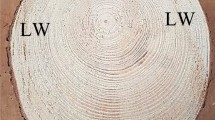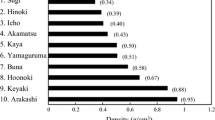Abstract
To clarify the wood properties and chemical composition of branches of Viburnum odoratissimum produced by unusual eccentric growth, we investigated growth strain (GS), basic density (D b), microfibril angle (MFA), elastic moduli (E L and E L/D b), creep deformation, cellulose crystalline features, and lignin structure in upper and lower sides of the branches, and considered the correlations among these factors. In most measuring positions, the distribution of GS showed that higher tensile GS was in the upper side and compressive GS was in the lower side of the branch, which combines GS features of reaction wood. However, the generation of GS in the lower side was different from that in compression wood, because E L/D b and MFA had a negative correlation. The creep compliance curves show that the upper-side wood had low rigidity and high viscosity, whereas the lower-side wood had large rigidity and low viscosity. Relative creep had a negative relation with MFA in the upper side, which is unusual. The cellulose crystalline features showed no obvious difference between both sides of the branch; however, the lignin with less β-O-4 proportion and less S units but more G units seemed to exist in the lower side because of a decreased syringyl/guaiacyl (S/G) molar ratio. This suggests that cell wall could be reinforced by lignin resulting in lower viscosity in the lower side of the branch. Additionally, the S/G ratio showed a relatively high correlation with GS in the lower side. These results suggest that lignin structure plays an important role in adapting to environmental changes during eccentric growth for V. odoratissimum.









Similar content being viewed by others
References
Aoyama W, Matsumura A, Tsutsumi Y, Nishida T (2001) Lignification and peroxidase in tension wood of Eucalyptus viminalis seedlings. J Wood Sci 47:419–424
Baillères H, Chanson B, Fournier M, Tollier MT, Monties B (1995) Structure, composition chimique et retraits de maturation du bois chez les clones d'Eucalyptus. Ann For Sci 52:157–172
Baillères H, Castan M, Monties B, Pollet B, Lapierre C (1997) Lignin structure in Buxus sempervirens reaction wood. Phytochemistry 44:35–39
Burghammer M, Műller M, Riekel C (2003) X-ray synchrotron radiation microdiffraction on fibrous biopolymers like cellulose and in particular spider silks. Recent Res Dev Macromol 7:103–125
Cave ID (1966) Theory of X-ray measurement of microfibril angle in wood. For Prod J 16:37–42
Cutter BE, Murphey WK (1972) X-ray measurement of crystallite size in wood. Wood Fiber 4:43–44
Jullien D, Gril J (2008) Growth strain assessment at the periphery of small-diameter trees using the two-grooves method: influence of operating parameters estimated by numerical simulations. Wood Sci Technol 42:551–565
Kennedy CJ, Cameron GJ, Šturcová A, Apperley DC, Altaner C, Wess TJ, Jarvis MC (2007) Microfibril diameter in celery collenchyma cellulose: X-ray scattering and NMR evidence. Cellulose 14:235–246
Kucera LJ, Philipson WR (1977) Growth eccentricity and reaction anatomy in branchwood of Drimys winteri and five native New Zealand tress. N Z J Bot 15:517–524
Kucera LJ, Philipson WR (1978) Growth eccentricity and reaction anatomy in branchwood of Pseudowintera colorata. Am J Bot 65:601–607
Lee CL (1961) Crystallinity of wood cellulose fiber. For Prod J 11:108–112
Meylan BA (1981) Reaction wood in Pseudowintera colorata—a vessel-less dicotyledon. Wood Sci Technol 15:81–92
Onaka F (1949) Studies on compression- and tension-wood. Wood Res 1:1–88 (in Japanese)
Pandey KK (1999) A study of chemical structure of soft and hardwood and wood polymers by FTIR spectroscopy. J Appl Polym Sci 71:1969–1975
Pandey KK, Pitman AJ (2003) FTIR studies of the changes in wood chemistry following decay by brown-rot and white-rot fungi. Int Biodeterior Biodegrad 52:151–160
Tanaka F, Koshijima T, Okamura K (1981) Characterization of cellulose in compression and opposite woods of a Pinus densiflora tree grown under the influence of strong wind. Wood Sci Technol 15:265–273
Timell TE (1986a) Compression wood in gymnosperms, vol 1. Springer, Berlin, pp 63–89
Timell TE (1986b) Compression wood in gymnosperms, vol 3. Springer, Berlin, pp 1757–1791
Timell TE (1986c) Compression wood in gymnosperms, vol 3. Springer, Berlin, pp 1799–1824
Tsoumis G (1991) Science and technology of wood: structure, properties, utilization. Van Nostrand Reinhold, New York, pp 88–91
Wang Y, Gril J, Sugiyama J (2009) Variation in xylem formation of Viburnum odoratissimum var. awabuki: growth strain and related anatomical features of branches exhibiting unusual eccentric growth. Tree Physiol 29:707–713
Washusen R, Evans R (2001) The association between cellulose crystallite width and tension wood occurrence in Eucalyptus globulus. IAWA J 33:235–243
Yamamoto H, Okuyama T, Iguchi M (1989) Measurement of growth stresses on the surface of a leaning stem. Mokuzai Gakkashi 35:595–601 (in Japanese)
Yoshida M, Okuyama T (2002) Techniques for measuring growth stress on the xylem surface using strain and dial gauges. Holzforschung 56:461–467
Yoshida M, Ohta H, Yamamoto H (2002a) Tensile growth stress and lignin distribution in the cell walls of yellow poplar, Liriodendron tulipifera Linn. Tree Struct Funct 16:457–464
Yoshida M, Ohta H, Yamamoto H (2002b) Tensile growth stress and lignin distribution in the cell walls of black locust (Robinia pseudoacacia). J Wood Sci 48:99–105
Yoshizawa N, Satoh M, Yokota S, Idei T (1993) Formation and structure of reaction wood in Buxus microphylla var. insularis Nakai. Wood Sci Technol 27:1–10
Acknowledgments
This study was supported by Grant-in-Aid for foreign research fellows (No. 20.08105) provided by the Japan Society for the Promotion of Science. The authors thank members of the Laboratory of Forest Resources Circulatory System, Kyoto Prefectural University, Japan for assistance with GC measurement.
Author information
Authors and Affiliations
Corresponding author
Additional information
Communicated by R. Matyssek.
Rights and permissions
About this article
Cite this article
Wang, Y., Gril, J., Clair, B. et al. Wood properties and chemical composition of the eccentric growth branch of Viburnum odoratissimum var. awabuki . Trees 24, 541–549 (2010). https://doi.org/10.1007/s00468-010-0425-x
Received:
Revised:
Accepted:
Published:
Issue Date:
DOI: https://doi.org/10.1007/s00468-010-0425-x




